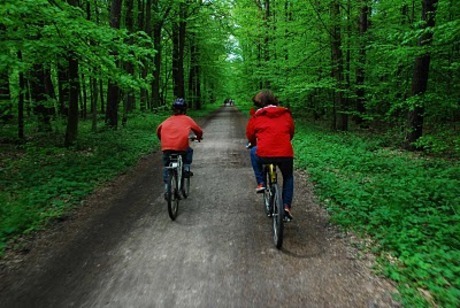Kabaty
Kabaty is the southernmost neighborhood of the city of Warsaw, located in its Ursynów district. Until the late 1980s it was a small village located south of Warsaw, between Warsaw and the Kabaty Woods. The area's most notable landmark is the Kabaty Palace, a manor which from 1937 housed the General Staff's Cipher Bureau, which among other things read German Enigma ciphers, originally solved in December 1932 at the General Staff building — the Saxon Palace — on Warsaw's Saxon, now Piłsudski, Square. Other historic landmarks include a mass grave of Polish soldiers from the January 1863 Uprising and a monument to the 183 victims of a 1987 Kabaty Woods air crash.
Kabaty has been inhabited for at least 600 years. The village of that name was first mentioned in 1386 as belonging to Andrzej Ciołek, standard-bearer of Płock. Prince Janusz I of Masovia granted it with Chełm Law (a local variant of the Magdeburg Law) and with certain degree of internal autonomy. Until 16th century the village remained a part of Ciołek family domain. In 1580 census it was reported as covering approximately 70 hectares. In early 17th century the village was transferred to the Piekarski family, but in 1656 was completely destroyed by the Swedish armies during The Deluge. In the 1721 the village of Kabaty, located on the Wisła River, had been purchased by Elżbieta Sieniawska, widow of Hetman Adam Mikołaj Sieniawski and owner of the Wilanów Palace. The village was rebuilt after a plague, and its character has been preserved since.
Elżbieta Sieniawska, who also bought the surrounding Kabaty Forest, ordered a protection of its animals and trees. Even the wood needed to build her new manor in 1726 was transported from Nieporęt rather than from the surrounding forest. In 1775 the village had 16 houses and a szlachta manor. By 1827 it grew to 17 houses and 177 inhabitants, mostly serfs. In 1864, after the January Uprising, the village was administratively attached to Wilanów. By 1905 it had 38 houses and 319 inhabitants. After Poland regained her independence in 1918, the village became a popular summer vacations place for the nearby town of Warsaw. The forest has been parcelled and a small resort was built there with 8 houses and 61 permanent inhabitants (in addition to 59 houses with 397 inhabitants in the village itself).
In 1937 the Cipher Bureau moved to the Kabaty manor. The following year, Warsaw President Stefan Starzyński purchased the Kabaty Woods for the city and turned them into a park and forest reserve. The Woods are now named after Starzyński. During World War II, they were a scene of partisan warfare against Poland's German occupiers. The heaviest fighting around Kabaty took place during the 1944 Warsaw Uprising, when Home Army units from southern Poland sought to break through to Warsaw via the Woods.
After the war, the village and the fields adjacent to the Woods were nationalized and treated as a space for Warsaw's further expansion. It was not until 1951, however, that it became part of Warsaw, included in the newly-created borough of Ursynów. In the 1990s the area was built up with apartment blocks and single-family houses, and agricultural activity was discontinued. The area is now one of the fastest-growing parts of Warsaw. Due to its proximity to the Woods — a popular weekend destination for Varsovians — it is considered especially desirable among the middle class.Kabaty has two Warsaw Metro facilities: the Kabaty train yard, and the Kabaty station itself, the southern terminus of line no. 1, beneath the intersection of Wąwozowa Street and KEN Avenue.
The Kabaty Forest is delightful place to go for a walk, and an area missed by most travellers. There are well marked out, wide, straight footpaths, like a grid system, so it is easy to work out which way to go. I would recommend going there during the week as it becomes crowded at weekends. There are occasional seats and sheltered areas for an alfresco lunch. Get off the metro at the last stop at Kabaty and carry on walking in the same direction as the train, the forest is in the same direction. You should notice a large British named supermarket on your left, ideal to pick up a snack & a drink. Walk past the bus stops and at the rear of the supermarket is a path which is a shortcut towards the forest. By now you should see the forest ahead of you and the tarmac strip take you to one of the main footpaths.
Best way to get there from city center is to take subway - to the first station of the single line [Kabaty]. On the ground level you should see Tesco supermarket. Then walk some 300 meters to the south and tou are in the entrance to forest.




